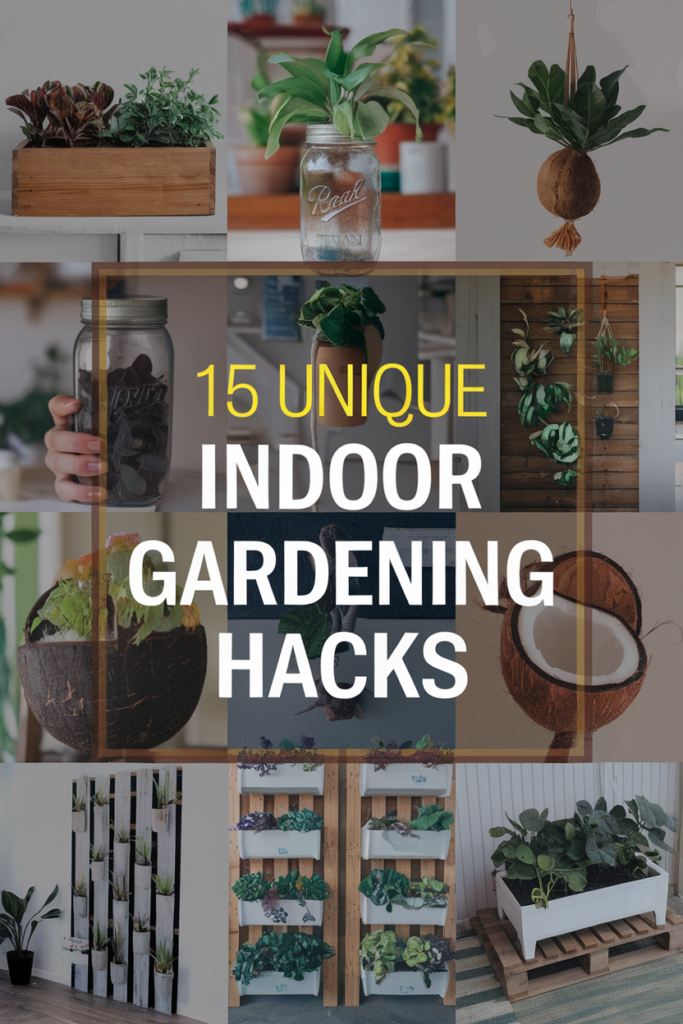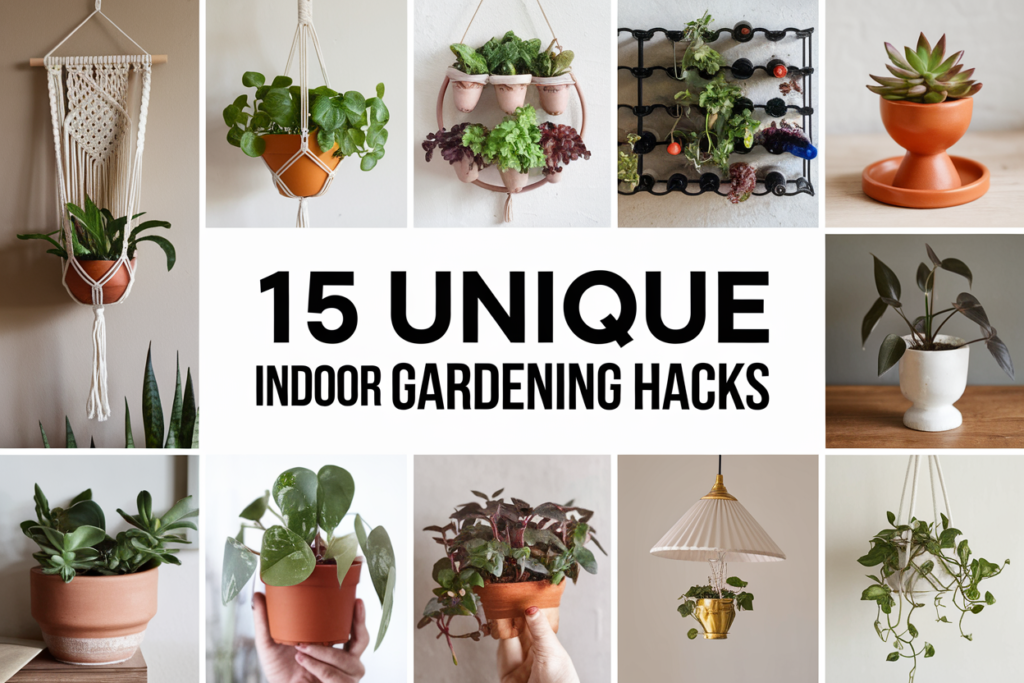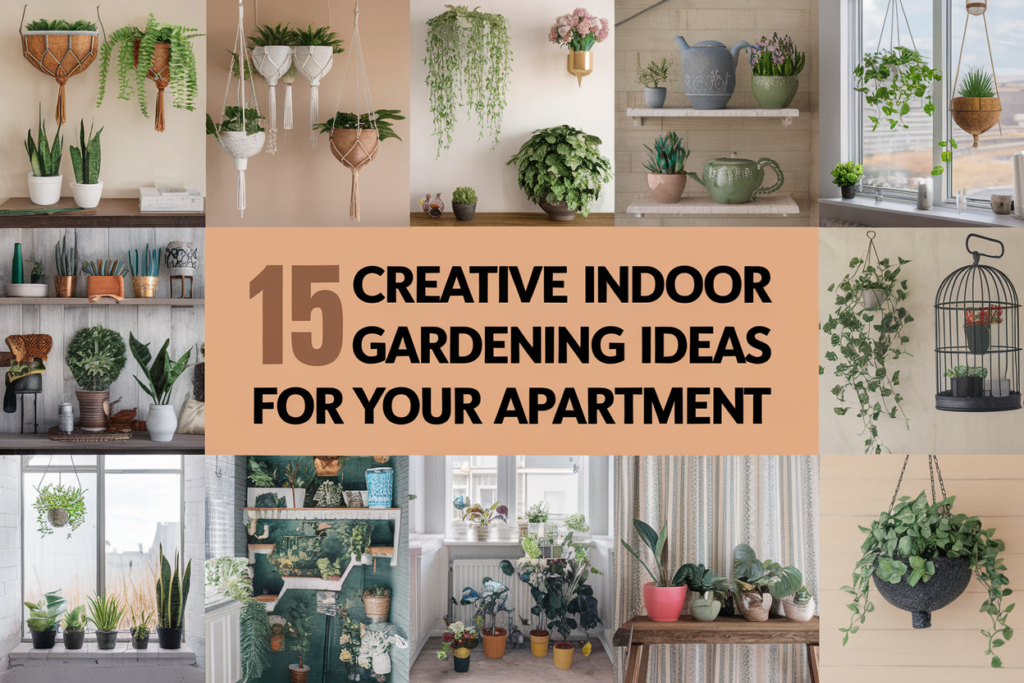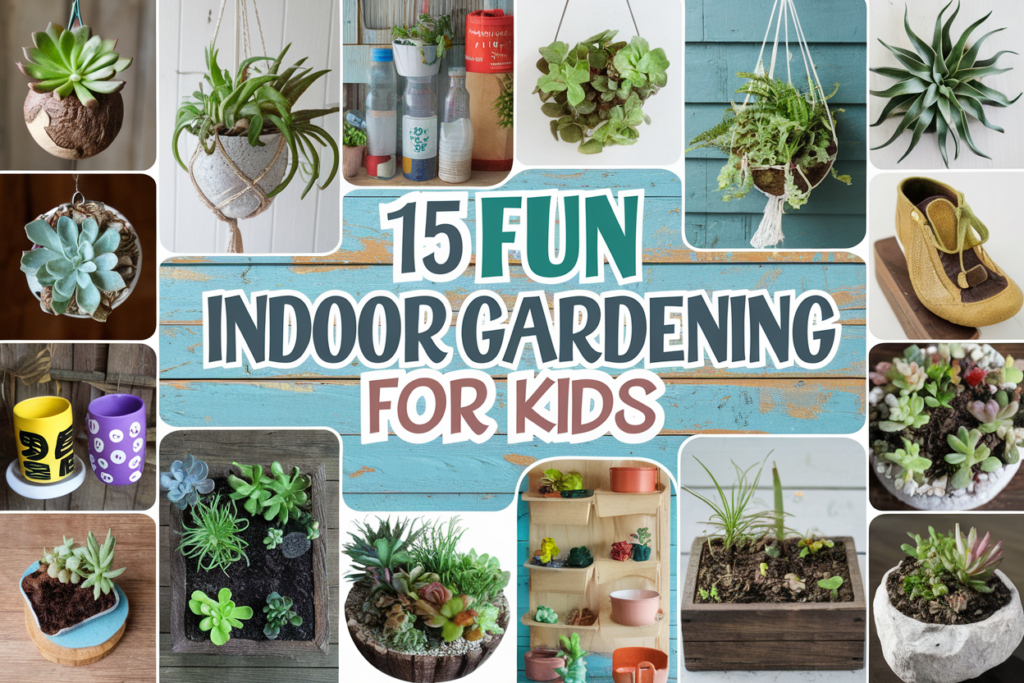Indoor gardening doesn’t have to be complicated or boring! With these 15 unique hacks, you’ll discover fun and creative ways to nurture your plants, save space, and make your indoor garden flourish. Whether you’re a seasoned gardener or just starting out, there’s something here for everyone to enjoy and try out.
Use Led Grow Lights To Extend Sunlight Exposure For Indoor Plants.
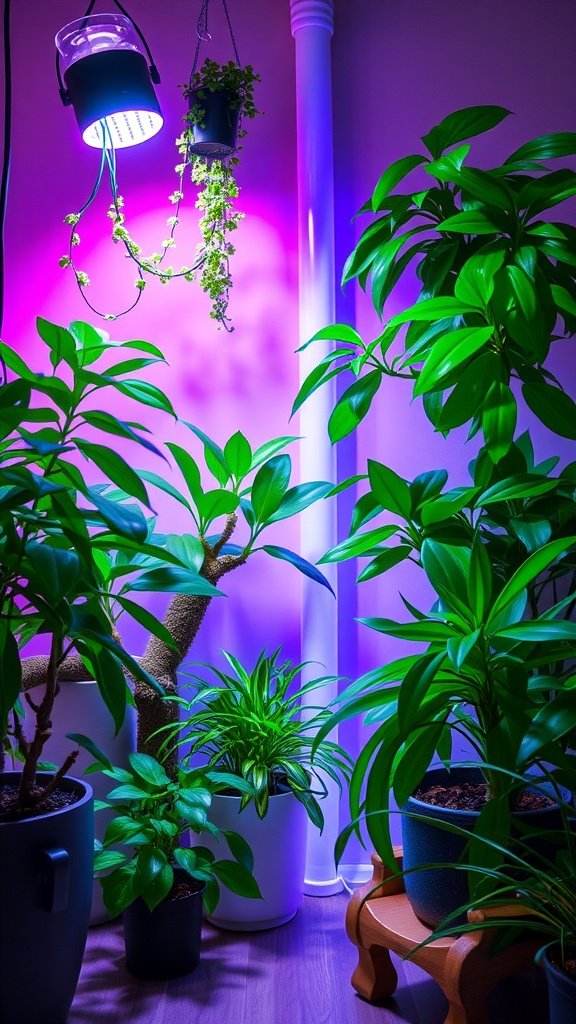
If you’re looking to give your indoor plants a boost, LED grow lights are a fantastic option. They provide the perfect spectrum of light that plants thrive on. The image shows a cozy setup where plants are happily growing under the glow of these lights.
The vibrant colors of the grow lights can really make your indoor garden pop. You can see how the plants are reaching towards the light, showcasing their need for that extra brightness. This added light is especially helpful during those darker months when natural sunlight is limited.
When using LED grow lights, consider the distance from the plants. Placing them too close can cause leaf burn, while too far can limit growth. Finding the right balance will help your plants flourish indoors. You’ll be amazed at how much healthier your plants can look with just a little extra light.
Besides helping with growth, LED lights can add a unique atmosphere to your space. It’s a great way to create a lively, green corner in your home. So, if you’re passionate about indoor gardening, investing in LED grow lights might just be your next step!
Recycle Coffee Grounds As Natural Fertilizer For Houseplants.

If you’re a coffee lover with a passion for houseplants, this hack is perfect for you. The image shows a bright and cheerful indoor garden, filled with vibrant green plants sitting beside a sunny window. In one container, you can see coffee grounds layered on top of the soil. This simple addition can give your plants a nutrient boost.
Coffee grounds are rich in nitrogen, making them an excellent natural fertilizer. Just sprinkle some used coffee grounds around the base of your plants. They improve soil structure, enhance drainage, and attract beneficial worms. Plus, they can help keep pests away!
Another benefit? Coffee grounds can help acidify the soil, which is great for plants like blueberries and azaleas. If you’re worried about the smell, fear not; when mixed into the soil, they won’t create any odors. This eco-friendly recycling hack turns your waste into a gardening goldmine.
Create A Self-Watering System Using Wine Bottles.
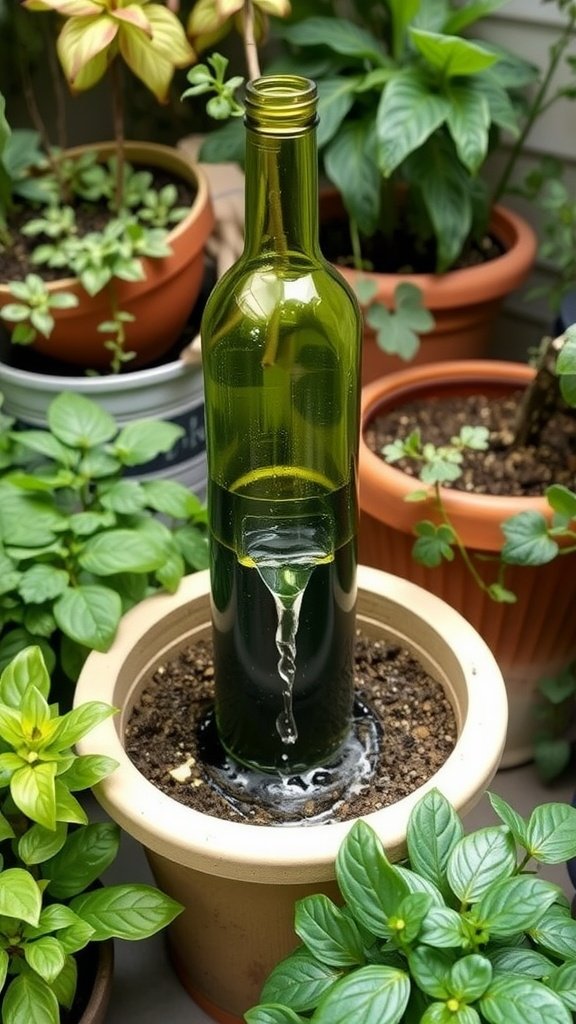
Have you ever thought about how to keep your plants hydrated without constant monitoring? Using wine bottles for a self-watering system is a clever and simple solution! In the image, you can see an empty wine bottle inverted in a pot filled with soil. The idea is to let the water slowly drip into the soil, providing a steady moisture level for your plants.
To set this up, start by cleaning out an empty wine bottle. Once it’s ready, fill it with water. Then, carefully reinsert it upside down into the soil of your potted plant. The neck of the bottle should sit just above the soil, while the water will seep out as needed. This method is perfect for busy schedules or even while you’re on vacation!
Not only does this hack help with watering, but it also adds a rustic touch to your indoor garden. Plus, it’s a smart way to recycle those wine bottles. So, gather your empty bottles and give this idea a go. Your plants will thank you!
Group Plants Together To Increase Humidity Naturally.
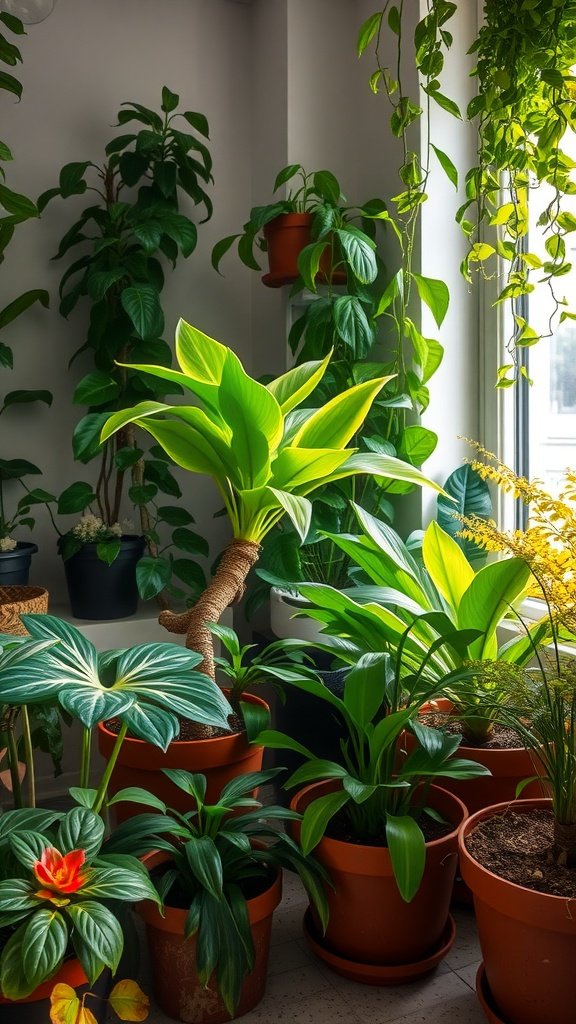
Grouping plants together is a smart and effective way to boost humidity levels in your indoor garden. When plants are close to each other, they create a mini ecosystem where moisture from their leaves evaporates into the air. This is especially helpful for tropical plants that thrive in humid conditions.
In the image, you can see a vibrant collection of plants bunched together. The lush green leaves and varied shapes create a beautiful display while also working together to enhance humidity. Notice how some plants have larger leaves which can release even more moisture into the air, benefiting their neighbors.
This cozy gathering of plants not only looks appealing but also helps maintain a healthier environment for them. The more humidity in the air, the less you’ll need to water them, allowing you to enjoy their beauty with less effort.
Place Plants In The Kitchen For Extra Moisture From Cooking.
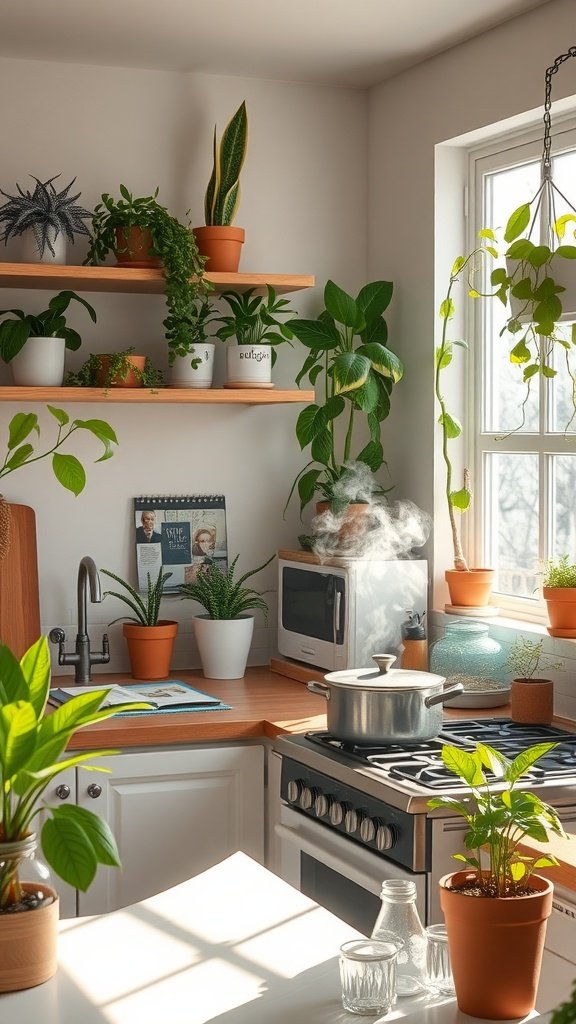
Putting plants in your kitchen is a simple way to boost both humidity and aesthetics. As you cook, steam rises from pots and pans, creating a perfect environment for plants that love moisture.
In the image, you can see a cozy kitchen filled with various plants. They are strategically placed near the window and on shelves, soaking up the light and humidity. This setup not only looks beautiful but also benefits the plants.
Plants like ferns and peace lilies thrive in this kind of setting. They can help purify the air while adding a touch of nature to your cooking space. You get the added benefit of fresh herbs right at your fingertips, enhancing your culinary creations.
Consider pots that complement your kitchen’s style, like terracotta or ceramic. With a little care, your kitchen garden can flourish, making cooking even more enjoyable.
Use Clear Containers To Monitor Water Levels In Potted Plants.
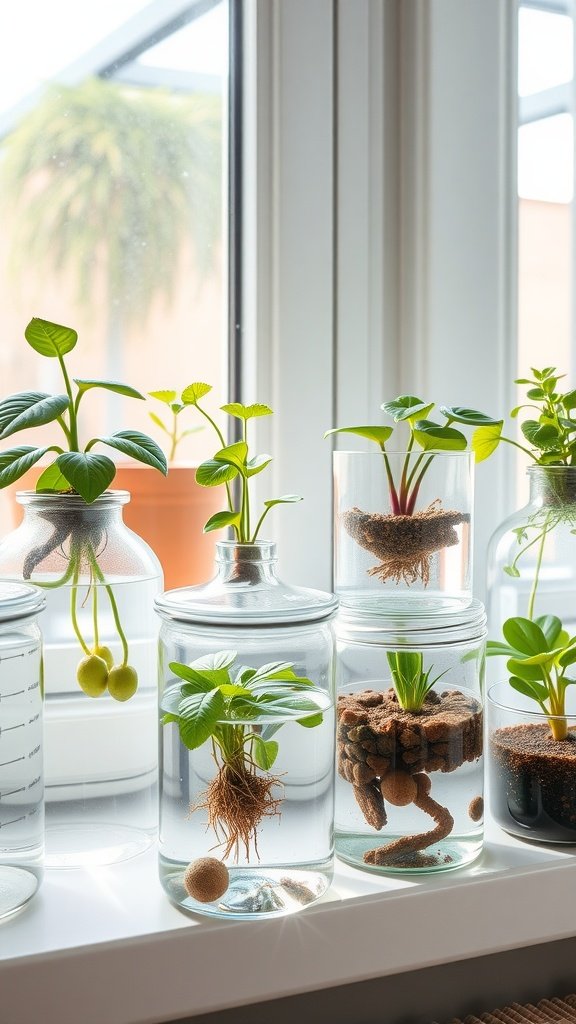
Using clear containers for your indoor plants is a simple yet effective hack. It allows you to see the water levels at a glance. This is handy for keeping your plants healthy and happy. You can quickly tell when it’s time to water without guesswork.
In the image, you can see various plants in clear jars filled with water. Each jar shows off the roots and water levels. This not only looks nice but also serves a practical purpose. You can spot any issues, like murky water or root rot, before they become big problems.
Furthermore, this method adds a unique touch to your decor. It creates an eye-catching display by showcasing the beauty of the roots and the plants together. Clear containers bring a fresh vibe to any room.
So, if you’re looking to brighten up your space while keeping an eye on your plants’ needs, clear containers are a great choice. You’ll enjoy watching your plants thrive while keeping your watering routine simple!
Opt For Slow-Release Fertilizers For Consistent Nourishment.
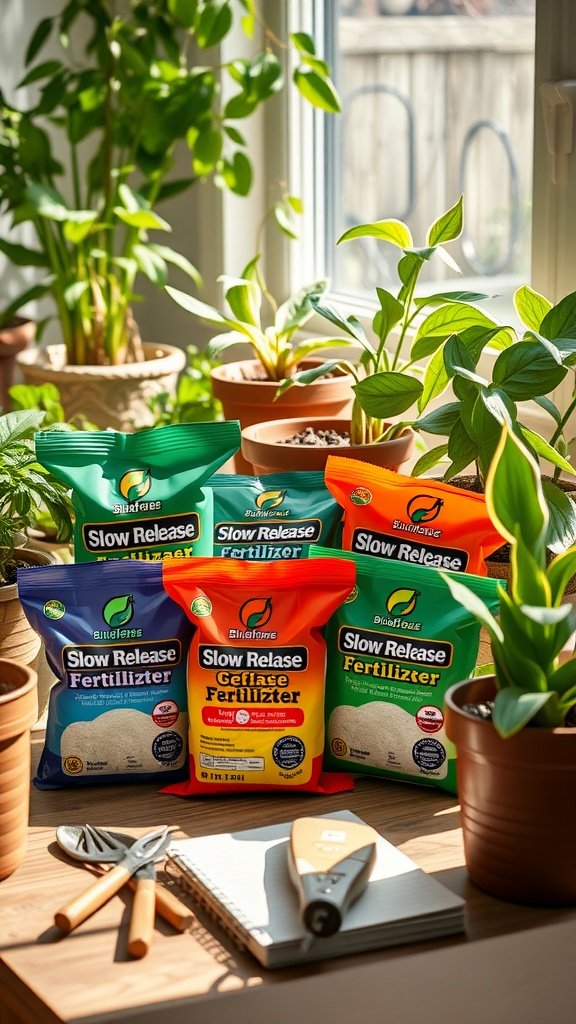
In the image, you see a cozy indoor garden scene filled with vibrant green plants basking in natural light. Surrounding them are various bags of slow-release fertilizers, each promising to nourish your plants over time. These fertilizers are designed to release nutrients gradually, ensuring that your plants receive consistent care without the risk of over-fertilization.
Using slow-release fertilizers can take the stress out of plant care. Instead of worrying about when to feed your plants, you can simply apply the fertilizer and let it do its job. This is especially helpful for busy plant parents who want their green friends to thrive without constant attention. The bags in the image suggest a variety of options, showcasing how easy it is to find the right fit for your indoor garden.
In addition to convenience, slow-release fertilizers promote healthier growth. They provide essential nutrients steadily, allowing your plants to absorb what they need at their own pace. This method supports strong root development and lush foliage, creating a thriving indoor environment. So next time you’re shopping for plant supplies, consider picking up a bag of slow-release fertilizer to keep your plants happy and healthy.
Reuse Water From Boiled Vegetables For Plant Hydration.
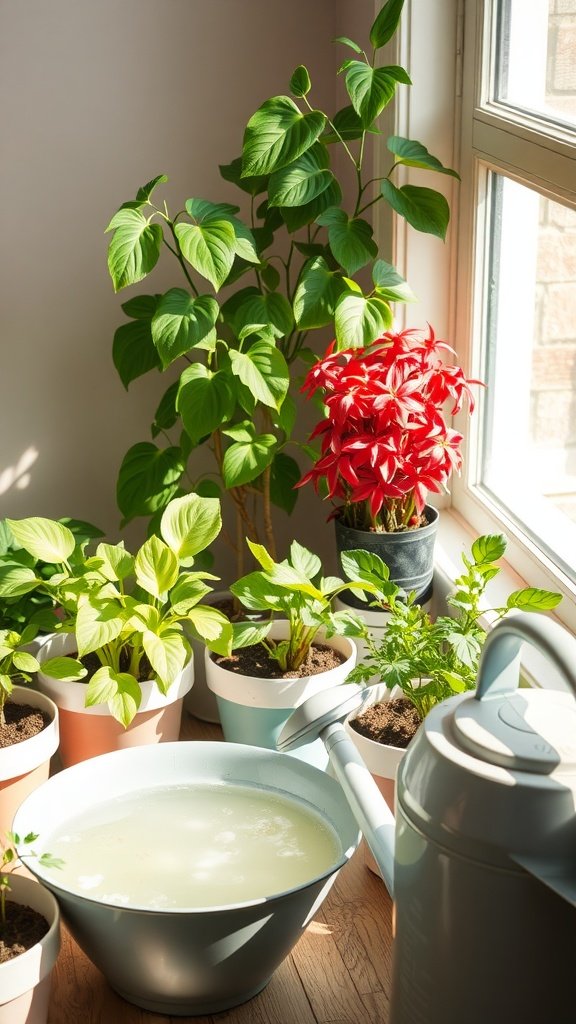
Using water from boiled vegetables is a simple yet effective way to nourish your indoor plants. This image shows a bowl filled with water sitting near a variety of healthy plants basking in sunlight.
The water contains nutrients released from the vegetables during cooking, making it a great source of hydration for your plants. Instead of pouring this nutrient-rich water down the drain, you can give your plants a treat!
When you boil vegetables, let the water cool down before using it on your plants. The warmth helps to activate the nutrients, and your plants will love it. Just make sure the water isn’t salted or flavored, as this could harm your plants.
As you can see in the photo, there are many pots of plants thriving beside the bowl. This hack not only helps keep your plants healthy but also reduces waste.
Repurpose Old Plastic Bottles As Mini Greenhouses.
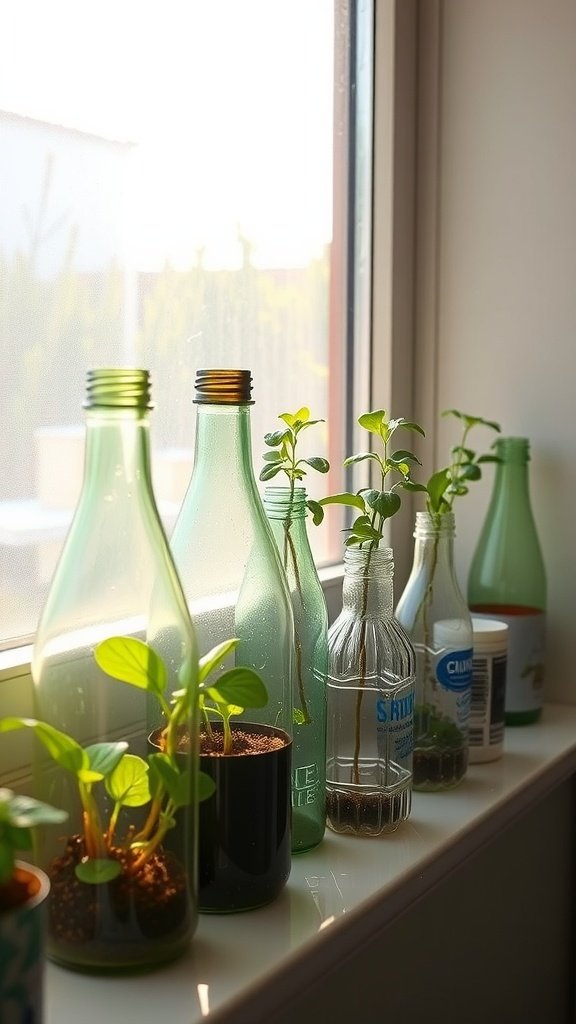
Using old plastic bottles for indoor gardening is a simple and fun way to create mini greenhouses. This method helps plants thrive by maintaining warmth and humidity. You can see in the image a variety of bottles lined up by a window, each containing soil and small plants. They are perfect for nurturing seedlings and keeping them protected.
To start, gather any plastic bottles you have at home. Cut the bottles in half and place the bottom half into the soil. Make sure to leave the cap on to create a greenhouse effect. You can also use clear bottles to allow sunlight to reach the plants. It’s an easy and eco-friendly way to give your plants a cozy environment.
Make sure to monitor the moisture levels inside the bottles. If they become too humid, simply remove the cap for a bit. This method not only saves money but also helps reduce waste. Plus, seeing your plants grow in these quirky greenhouses can be very satisfying!
Add Pebbles To The Bottom Of Pots For Better Drainage.

Using pebbles at the bottom of your pots is a smart trick for keeping your plants happy. The image shows a clay pot with colorful pebbles placed neatly at the bottom. This simple addition can help prevent water from pooling at the base of the pot, which can lead to root rot.
When you water your plants, the excess water needs a way to escape. Pebbles create a drainage layer that allows water to move freely, ensuring your roots get the moisture they need without sitting in soggy soil. This is especially useful for indoor gardening, where maintaining proper moisture levels is crucial.
So, next time you plant something new, grab some pebbles! They not only serve a practical purpose but can also add a decorative touch to your pots. It’s a win-win for plant lovers!
Use A Humidifier To Boost Moisture For Tropical Plants.
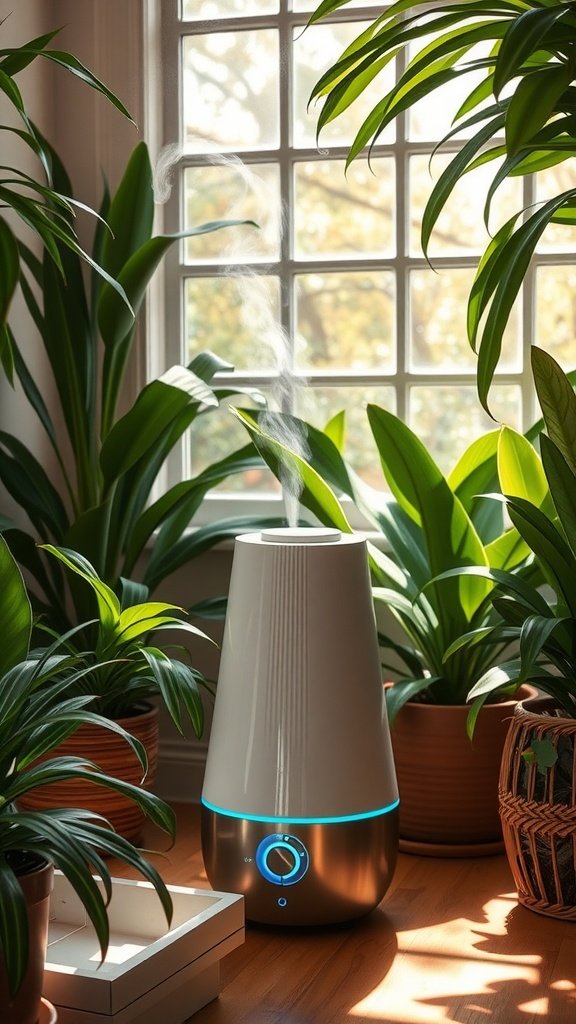
Indoor gardening can be a joy, especially when you have tropical plants. These beauties thrive in humid environments, making a humidifier a handy tool. The image shows a stylish humidifier surrounded by lush green plants, perfectly illustrating this idea.
Tropical plants like ferns and orchids love moisture in the air. Using a humidifier helps replicate their natural environment. By setting it up near your plants, you can create a cozy, humid atmosphere that promotes their growth. This means healthier leaves and more vibrant blooms!
Moreover, humidifiers can help prevent issues like leaf drop or browning tips, common signs of dry air. Simply adjust the settings to find the right level of moisture. It’s an easy way to keep your plants happy and thriving!
Grow Herbs In Mason Jars For A Space-Saving Kitchen Garden.

Mason jars are not just for canning; they make excellent containers for growing herbs indoors. This image showcases a bright kitchen window filled with jars of fresh herbs like mint, basil, and cilantro. The soft sunlight streaming in highlights the greens, making your kitchen feel alive and vibrant.
These jars are perfect for small spaces. Setting them by the window allows the plants to soak up natural light, which is essential for healthy growth. Plus, they add a charming touch to your decor.
Using mason jars means you can easily see the roots and soil. This way, you can monitor their health and growth. It’s also a conversation starter when you have friends over.
To grow your herbs, fill each jar with potting soil, plant your seeds or small plants, and keep them watered. Remember to rotate the jars occasionally for even sunlight exposure. Soon, you’ll have a mini herb garden right in your kitchen!
Keep Plants In Bathrooms With Natural Light And Moisture.

Bathrooms can be a perfect spot for plants, thanks to the natural light and humidity they often provide. The image shows a cozy bathroom scene filled with lush green plants, which thrive in these conditions. The sunlight coming through the window helps the plants absorb light, while the moisture from daily routines creates a mini greenhouse effect.
Placing plants near a window is key. The plants in the picture are strategically positioned to benefit from the light while enjoying the steam from the bath, which adds humidity. This environment is ideal for tropical plants like peace lilies or pothos, both shown here.
Adding plants to your bathroom not only looks great but can also purify the air. Their ability to thrive in a warm, moist space makes them low-maintenance and perfect for those who love greenery. Just ensure they get enough indirect light, and you’ll have a thriving indoor garden.
Rotate Plants Regularly For Even Sunlight Exposure.
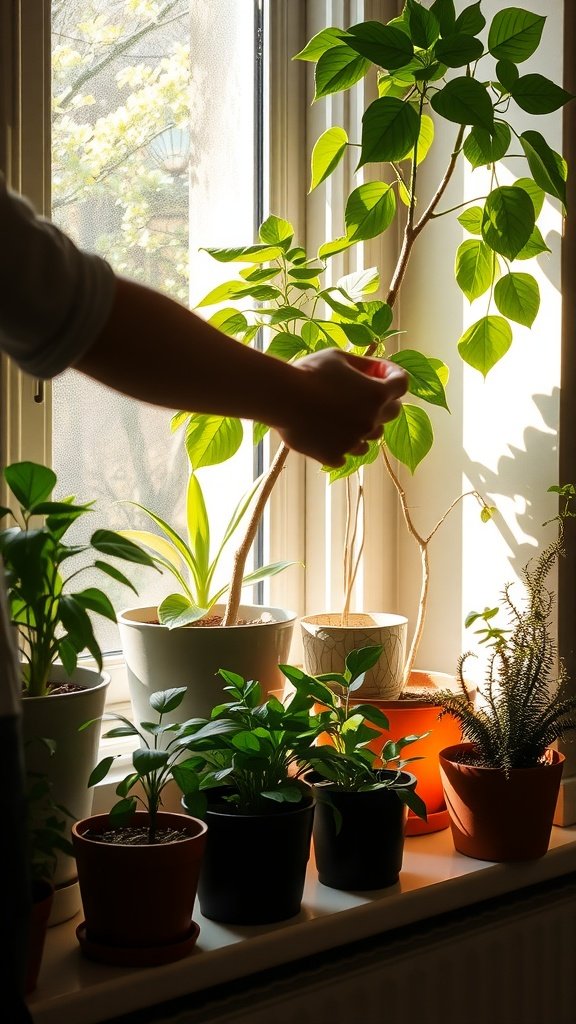
Keeping your indoor plants healthy and thriving often comes down to simple care routines. One effective method is to rotate your plants regularly. This practice ensures that every side of the plant gets equal sunlight, promoting balanced growth.
The image here captures a sunny window where a hand is gently adjusting a potted plant. The sunlight streams in, illuminating the vibrant green leaves. This setting emphasizes the importance of light in plant care. Plants naturally lean towards the sun, so rotating them helps prevent uneven growth and keeps them looking lush and full.
When you rotate your plants, aim for a quarter turn every couple of weeks. This small effort can make a big difference, leading to healthier foliage and a fuller appearance. Plus, it’s a great excuse to spend a little more time with your green friends!
Create A Diy Indoor Compost Bin With Kitchen Scraps.
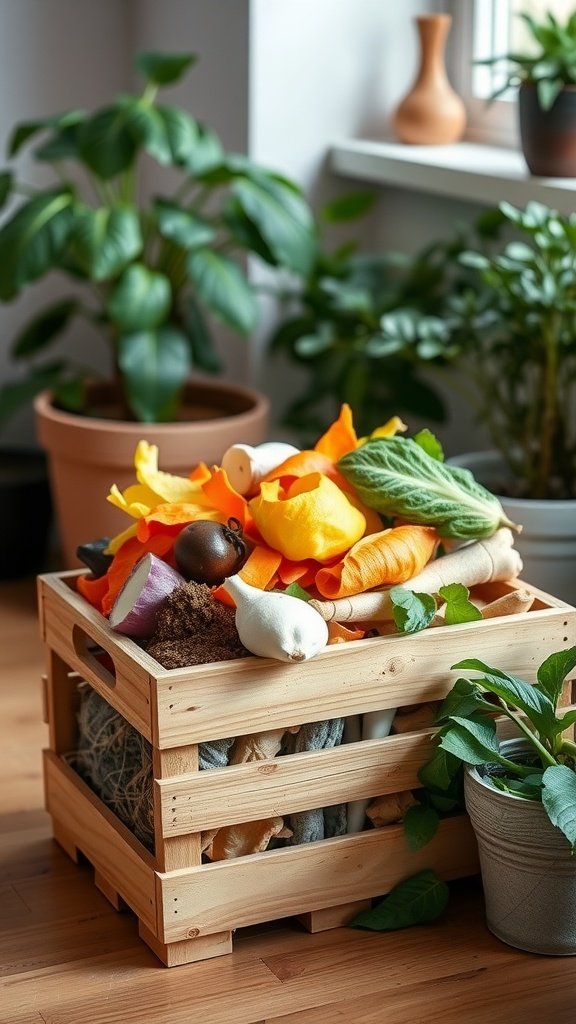
Creating a DIY indoor compost bin is a great way to turn kitchen scraps into nutrient-rich soil for your plants. The image showcases a wooden crate filled with vibrant vegetable peels, scraps, and other organic materials just waiting to decompose.
The wooden crate makes for a perfect compost bin, allowing airflow while keeping everything contained. You can easily add vegetable scraps, coffee grounds, and even some paper towels. Just remember to balance green materials like fruit and vegetable scraps with brown materials like cardboard and dry leaves.
Placing the compost bin near your kitchen makes it easy to toss in scraps. Just lift the lid and add those leftovers! Over time, you’ll end up with rich compost that can boost your indoor garden’s health. It’s a simple and sustainable hack that benefits both your plants and the environment.
